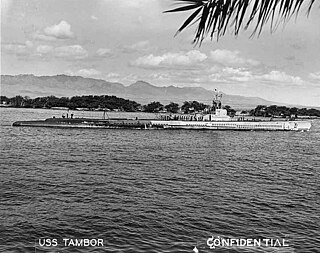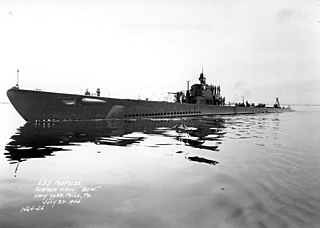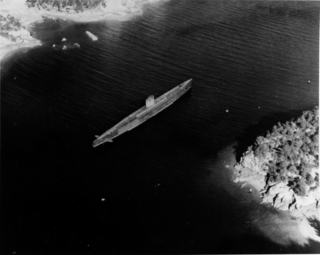
A submarine is a watercraft capable of independent operation underwater. It differs from a submersible, which has more limited underwater capability. The term is also sometimes used historically or colloquially to refer to remotely operated vehicles and robots, as well as medium-sized or smaller vessels, such as the midget submarine and the wet sub. Submarines are referred to as boats rather than ships irrespective of their size.

Type VII U-boats were the most common type of German World War II U-boat. 703 boats were built by the end of the war. The lone surviving example, U-995, is on display at the Laboe Naval Memorial located in Laboe, Schleswig-Holstein, Germany.

The Type II U-boat was designed by Nazi Germany as a coastal U-boat, modeled after the CV-707 submarine, which was designed by the Dutch dummy company NV Ingenieurskantoor voor Scheepsbouw Den Haag (I.v.S) and built in 1933 by the Finnish Crichton-Vulcan shipyard in Turku, Finland. It was too small to undertake sustained operations far away from the home support facilities. Its primary role was found to be in the training schools, preparing new German naval officers for command. It appeared in four sub-types.

U-boats were naval submarines operated by Germany, particularly in the First and Second World Wars. Although at times they were efficient fleet weapons against enemy naval warships, they were most effectively used in an economic warfare role and enforcing a naval blockade against enemy shipping. The primary targets of the U-boat campaigns in both wars were the merchant convoys bringing supplies from Canada and other parts of the British Empire, and from the United States, to the United Kingdom and to the Soviet Union and the Allied territories in the Mediterranean. German submarines also destroyed Brazilian merchant ships during World War II, causing Brazil to declare war on both Germany and Italy on 22 August 1942.

Type XXI submarines were a class of German diesel–electric Elektroboot submarines designed during the Second World War. One hundred and eighteen were completed, with four being combat-ready. During the war only two were put into active service and went on patrols, but these were not used in combat.

The German Type 212 class, also Italian Todaro class, is a diesel-electric submarine developed by Howaldtswerke-Deutsche Werft AG (HDW) for the German and Italian navies. It features diesel propulsion and an additional air-independent propulsion (AIP) system using Siemens proton exchange membrane (PEM) compressed hydrogen fuel cells. The submarines can operate at high speed on diesel power or switch to the AIP system for silent slow cruising, staying submerged for up to three weeks with little exhaust heat. The system is also said to be vibration-free, extremely quiet and virtually undetectable.

The Tambor-class submarine was a United States Navy submarine design, used primarily during World War II. They were the USN's first fully successful fleet submarine, and began the war close to the fighting. Six of the class were in Hawaiian waters or the Central Pacific on 7 December 1941, with Tautog at Pearl Harbor during the attack. They went on to see hard service; seven of the twelve boats in the class were sunk before the survivors were withdrawn from front-line service in early 1945; this was the highest percentage lost of any US submarine class. Tautog was credited with sinking 26 ships, the largest number of ships sunk by a US submarine in World War II. The Tambors attained the top speed of 21 knots (39 km/h) and range of 11,000 nautical miles (20,000 km) of the preceding Sargo class, and improvements included six bow torpedo tubes, a more reliable full diesel-electric propulsion plant, and improved combat efficiency with key personnel and equipment relocated to the conning tower. In some references, the Tambors are called the "T Class", and SS-206 through SS-211 are sometimes called the "Gar class".

The Porpoise class were submarines built for the United States Navy in the late 1930s, and incorporated a number of modern features that would make them the basis for subsequent Salmon, Sargo, Tambor, Gato, Balao, and Tench classes. In some references, the Porpoises are called the "P" class.
Air-independent propulsion (AIP), or air-independent power, is any marine propulsion technology that allows a non-nuclear submarine to operate without access to atmospheric oxygen. AIP can augment or replace the diesel-electric propulsion system of non-nuclear vessels.

The Type 214 is a diesel-electric submarine developed by Howaldtswerke-Deutsche Werft GmbH (HDW). It features diesel propulsion with an air-independent propulsion (AIP) system using Siemens polymer electrolyte membrane (PEM) hydrogen fuel cells. The class is exclusively designed for export market. The submarine class combines the design principles of the Type 209 family and the features of the Type 212A submarines. However, as an export design, it lacks some of the classified technologies of the smaller Type 212, the most important of which is probably the non-magnetic steel hull, which makes the Type 212 submarine difficult to detect using a magnetic anomaly detector.

The I-201-class submarines were submarines of the Imperial Japanese Navy during World War II. These submarines were of advanced design, built for high underwater speed, and were known as Sentaka-Dai type submarine or Sentaka type submarine. The type name, was shortened to Suichū Kōsoku Sensuikan Ō-gata.

The Type 206 is a class of diesel-electric submarines (U-boats) developed by Howaldtswerke-Deutsche Werft (HDW). Its design is based on the preceding Type 205 submarine class. These small and agile submarines were built during the Cold War to operate in the shallow Baltic Sea and attack Warsaw Pact shipping in the event of military confrontation. The pressure hulls were built out of non-magnetic steel to counter the threat of magnetic naval mines and make detection with MAD sensors more difficult. The low emission profile allowed the submarines in exercises to intrude even into well-protected opposing forces such as carrier formations with their screen.

The Type 201 was Germany's first U-boat class built after World War II.
German submarine U-718 was a short-lived Type VIIC U-boat built by Nazi Germany's Kriegsmarine for service during World War II. Due to an accident during training exercises five months after completion, U-718 never saw active service in the Kriegsmarine. Built at Hamburg during 1942 and 1943 and taking a year to complete, U-718 was a Type VIIC submarine and was intended for service in the Battle of the Atlantic.
German submarine U-954 was a Type VIIC submarine of Nazi Germany's Kriegsmarine in World War II.
German submarine U-205 was a Type VIIC U-boat of the Kriegsmarine during World War II. The submarine was laid down on 19 June 1940 by the Friedrich Krupp Germaniawerft yard at Kiel as yard number 634; launched on 20 March 1941; and commissioned on 3 May 1941 under the command of Franz-Georg Reschke.
German submarine U-239 was a Type VIIC U-boat of Nazi Germany's Kriegsmarine during World War II.
German submarine U-297 was a Type VIIC/41 U-boat of Nazi Germany's Kriegsmarine during World War II.
German submarine U-384 was a Type VIIC U-boat of Nazi Germany's Kriegsmarine during World War II.















